Unit 41 - Brand Management
VerifiedAdded on 2023/01/03
|14
|3752
|50
AI Summary
This unit on brand management explores the importance of branding as a marketing tool and the key components of managing brand equity. It discusses strategies for brand portfolio management and collaboration at a domestic and global level. It also covers measuring and managing brand value. Find study material, solved assignments, and essays on brand management at Desklib.
Contribute Materials
Your contribution can guide someone’s learning journey. Share your
documents today.
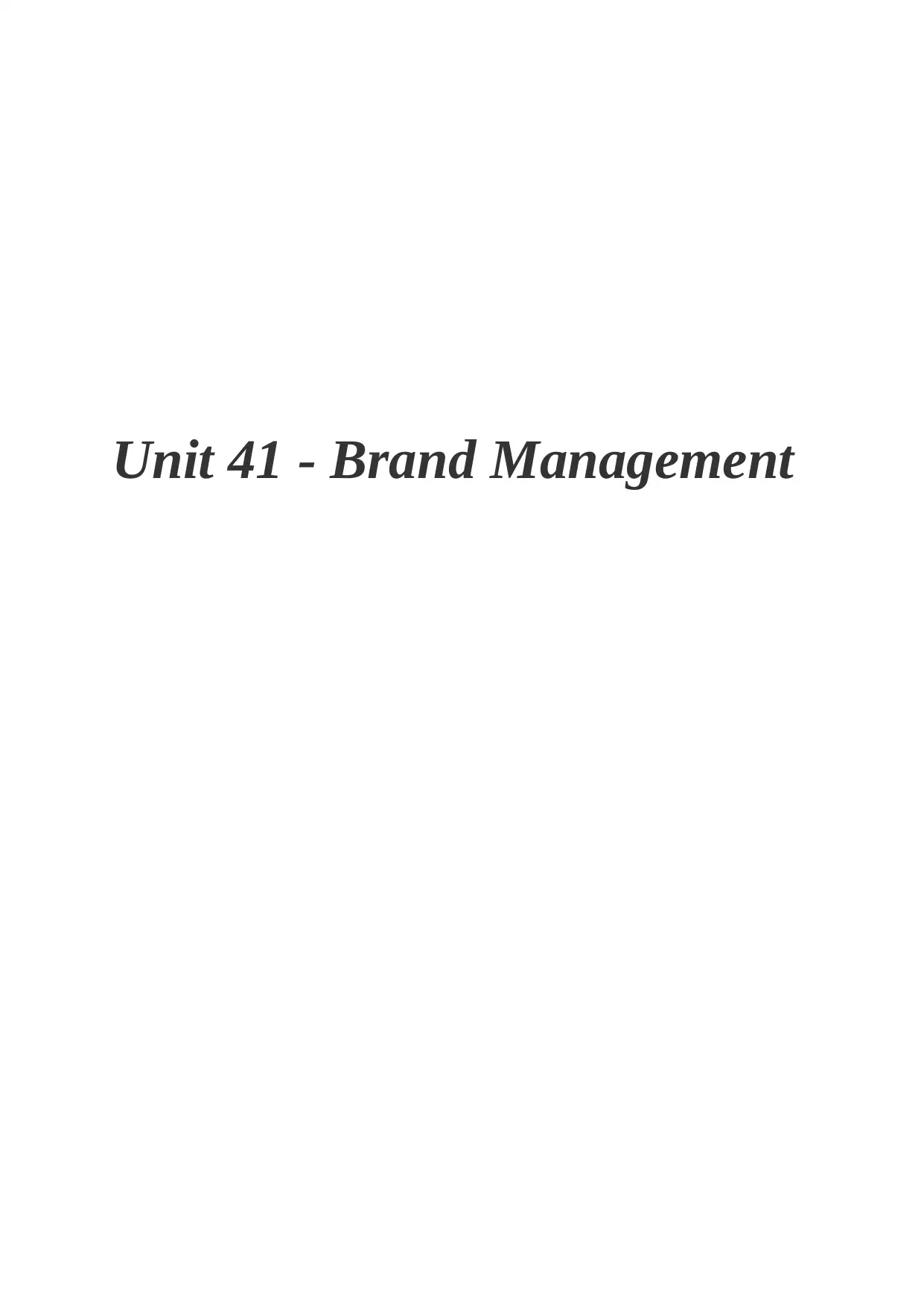
Unit 41 - Brand Management
Secure Best Marks with AI Grader
Need help grading? Try our AI Grader for instant feedback on your assignments.
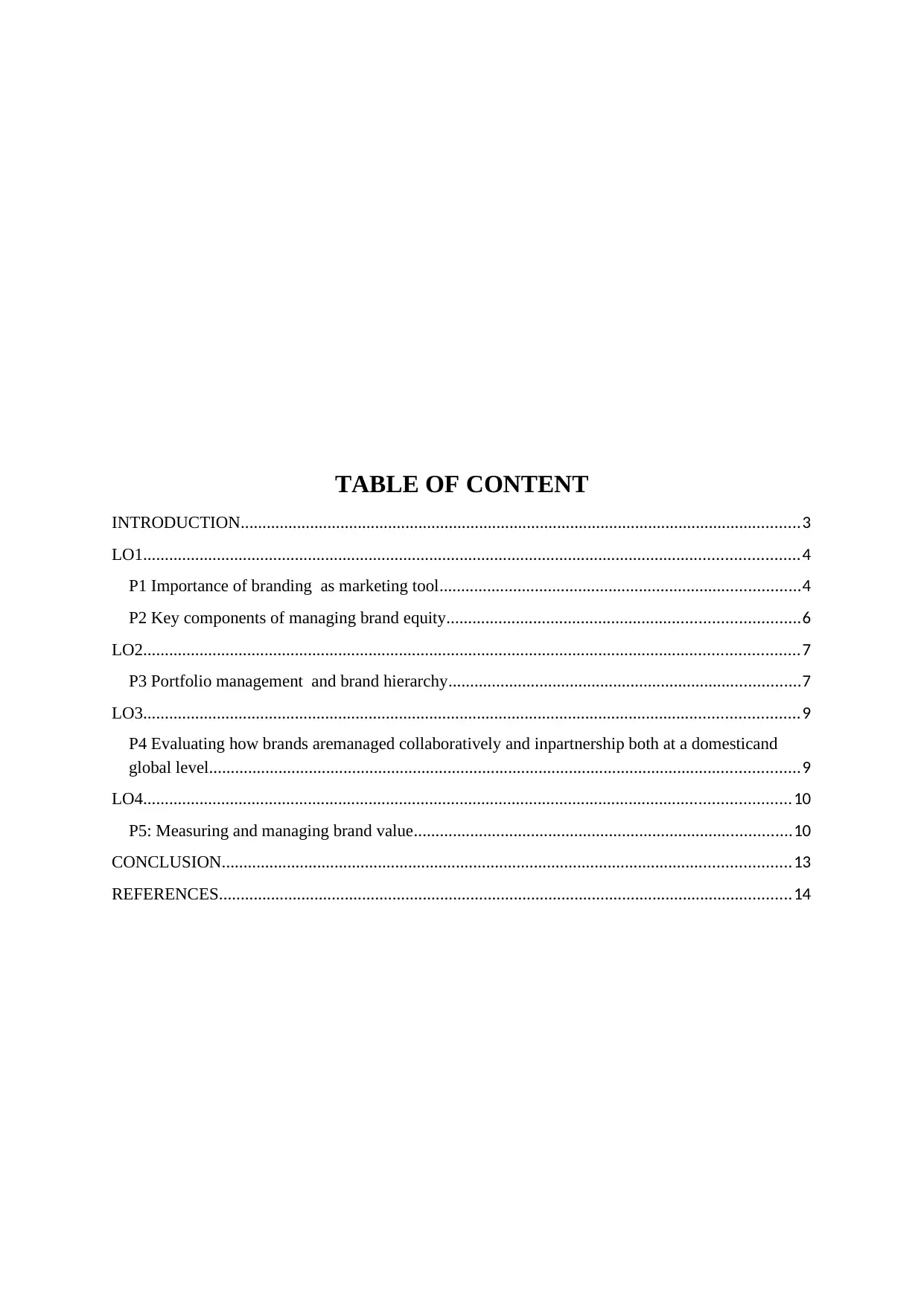
TABLE OF CONTENT
INTRODUCTION.................................................................................................................................3
LO1.......................................................................................................................................................4
P1 Importance of branding as marketing tool...................................................................................4
P2 Key components of managing brand equity.................................................................................6
LO2.......................................................................................................................................................7
P3 Portfolio management and brand hierarchy.................................................................................7
LO3.......................................................................................................................................................9
P4 Evaluating how brands aremanaged collaboratively and inpartnership both at a domesticand
global level........................................................................................................................................9
LO4.....................................................................................................................................................10
P5: Measuring and managing brand value.......................................................................................10
CONCLUSION...................................................................................................................................13
REFERENCES....................................................................................................................................14
INTRODUCTION.................................................................................................................................3
LO1.......................................................................................................................................................4
P1 Importance of branding as marketing tool...................................................................................4
P2 Key components of managing brand equity.................................................................................6
LO2.......................................................................................................................................................7
P3 Portfolio management and brand hierarchy.................................................................................7
LO3.......................................................................................................................................................9
P4 Evaluating how brands aremanaged collaboratively and inpartnership both at a domesticand
global level........................................................................................................................................9
LO4.....................................................................................................................................................10
P5: Measuring and managing brand value.......................................................................................10
CONCLUSION...................................................................................................................................13
REFERENCES....................................................................................................................................14

INTRODUCTION
Brand management can be understood as process of functional scale marketing for
competitive increased functional scale value development of brands over time, based on
prices and productive designs for building new leveraged goals among competitive industry.
M&S is one of the best fashion retail company having presence in various parts of world and
also with digital services gaining wider pace of goodwill. The report will be analysing
various aspects of brand management importance and components which bring on effective
goal formulation on larger time run for determining operational paradigms. Report will be
Brand management can be understood as process of functional scale marketing for
competitive increased functional scale value development of brands over time, based on
prices and productive designs for building new leveraged goals among competitive industry.
M&S is one of the best fashion retail company having presence in various parts of world and
also with digital services gaining wider pace of goodwill. The report will be analysing
various aspects of brand management importance and components which bring on effective
goal formulation on larger time run for determining operational paradigms. Report will be
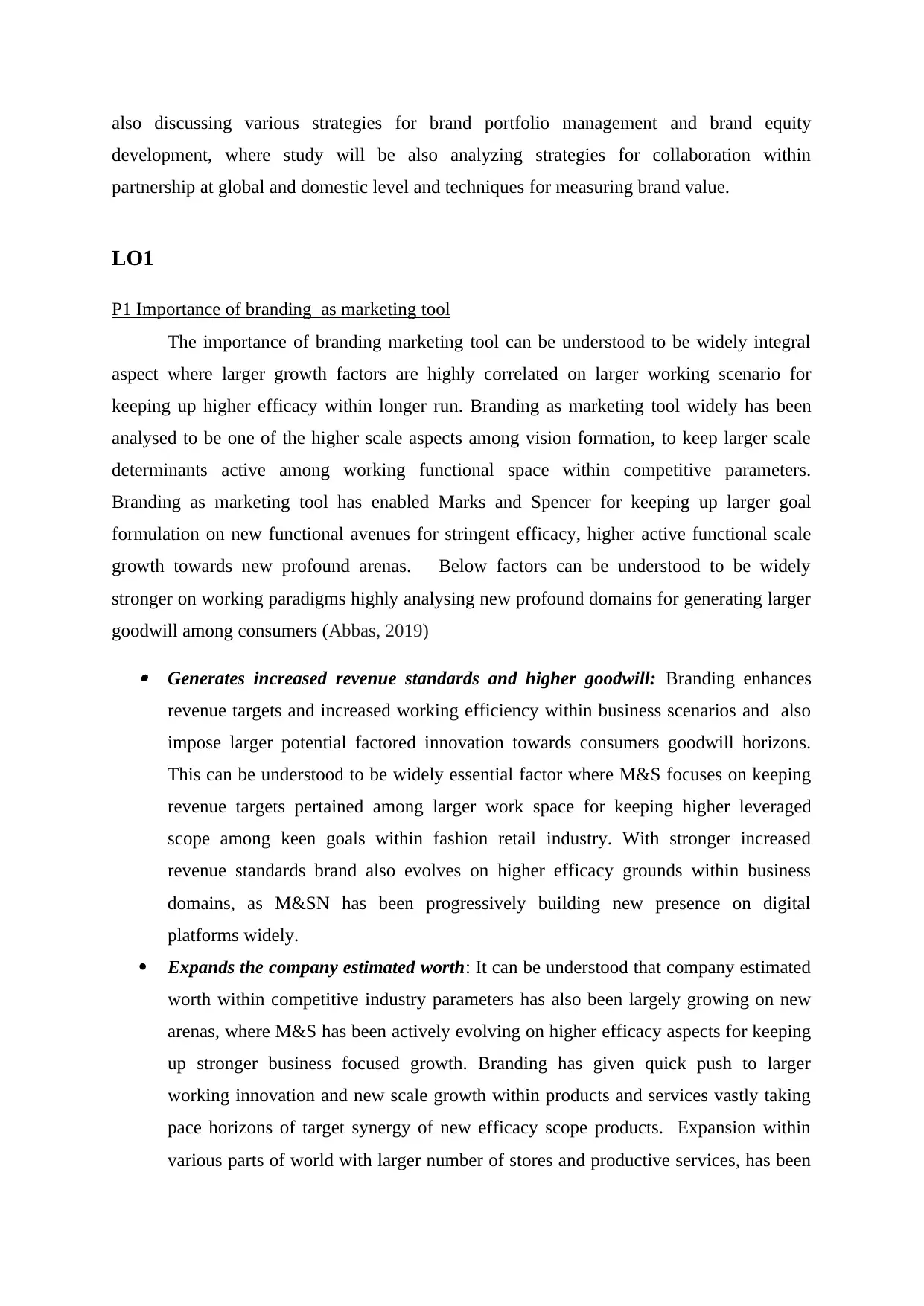
also discussing various strategies for brand portfolio management and brand equity
development, where study will be also analyzing strategies for collaboration within
partnership at global and domestic level and techniques for measuring brand value.
LO1
P1 Importance of branding as marketing tool
The importance of branding marketing tool can be understood to be widely integral
aspect where larger growth factors are highly correlated on larger working scenario for
keeping up higher efficacy within longer run. Branding as marketing tool widely has been
analysed to be one of the higher scale aspects among vision formation, to keep larger scale
determinants active among working functional space within competitive parameters.
Branding as marketing tool has enabled Marks and Spencer for keeping up larger goal
formulation on new functional avenues for stringent efficacy, higher active functional scale
growth towards new profound arenas. Below factors can be understood to be widely
stronger on working paradigms highly analysing new profound domains for generating larger
goodwill among consumers (Abbas, 2019)
Generates increased revenue standards and higher goodwill: Branding enhances
revenue targets and increased working efficiency within business scenarios and also
impose larger potential factored innovation towards consumers goodwill horizons.
This can be understood to be widely essential factor where M&S focuses on keeping
revenue targets pertained among larger work space for keeping higher leveraged
scope among keen goals within fashion retail industry. With stronger increased
revenue standards brand also evolves on higher efficacy grounds within business
domains, as M&SN has been progressively building new presence on digital
platforms widely.
Expands the company estimated worth: It can be understood that company estimated
worth within competitive industry parameters has also been largely growing on new
arenas, where M&S has been actively evolving on higher efficacy aspects for keeping
up stronger business focused growth. Branding has given quick push to larger
working innovation and new scale growth within products and services vastly taking
pace horizons of target synergy of new efficacy scope products. Expansion within
various parts of world with larger number of stores and productive services, has been
development, where study will be also analyzing strategies for collaboration within
partnership at global and domestic level and techniques for measuring brand value.
LO1
P1 Importance of branding as marketing tool
The importance of branding marketing tool can be understood to be widely integral
aspect where larger growth factors are highly correlated on larger working scenario for
keeping up higher efficacy within longer run. Branding as marketing tool widely has been
analysed to be one of the higher scale aspects among vision formation, to keep larger scale
determinants active among working functional space within competitive parameters.
Branding as marketing tool has enabled Marks and Spencer for keeping up larger goal
formulation on new functional avenues for stringent efficacy, higher active functional scale
growth towards new profound arenas. Below factors can be understood to be widely
stronger on working paradigms highly analysing new profound domains for generating larger
goodwill among consumers (Abbas, 2019)
Generates increased revenue standards and higher goodwill: Branding enhances
revenue targets and increased working efficiency within business scenarios and also
impose larger potential factored innovation towards consumers goodwill horizons.
This can be understood to be widely essential factor where M&S focuses on keeping
revenue targets pertained among larger work space for keeping higher leveraged
scope among keen goals within fashion retail industry. With stronger increased
revenue standards brand also evolves on higher efficacy grounds within business
domains, as M&SN has been progressively building new presence on digital
platforms widely.
Expands the company estimated worth: It can be understood that company estimated
worth within competitive industry parameters has also been largely growing on new
arenas, where M&S has been actively evolving on higher efficacy aspects for keeping
up stronger business focused growth. Branding has given quick push to larger
working innovation and new scale growth within products and services vastly taking
pace horizons of target synergy of new efficacy scope products. Expansion within
various parts of world with larger number of stores and productive services, has been
Secure Best Marks with AI Grader
Need help grading? Try our AI Grader for instant feedback on your assignments.

keenly bringing on wider functional push to keep up leveraging focus on new quest
arenas. There has been also productive enlargement of vision and new scale active
growth on higher efficacy scenarios to potentially enhance wider business targets, also
determine wider domains of keen working targets and also upscale new working
efficacy (Bhagwat and Bach,2016).
Creates consumers preferences for product or services behind brand: M&S aims to
create consumer preferences strong and competitively advance, widely for keeping
innovation within products and services also stringently strong and also attains higher
growth competitive efficacy among business goals. There has been also productive
shift among customers business demands which pertains larger goals efficacy within
new horizons for target growth among branding arenas where there is also
competitive progression build on. This factor enables us to analyse that M&S by
developing best consumers preferences within business horizons aims to serve
consumers competitively among market share, with high evolving growth aspects and
new scale target determinants.
Larger fostering of innovation and distinction within products: M&S by larger
active fostering of innovation within products, services by digital marketing avenues
and new scale active functional growth has been focusing on distinction parameters.
There has been also competitive growth within innovation business horizons for
keeping larger scale active synergy, to potentially be competitive on new arenas and
also upscale higher grounds targets on best determinants. The business industry
paradigms within fashion retail scope have been actively evolving on new scale
metrics, where brainstorming of new ideas and competencies are developed among
larger horizons. This has been also evolving as one of the keen strength for generating
higher work growth efficacy among customer’s goodwill metrics, which also
potentially gives push to revenue targets (Brexendorf. and Keller,2017).
These factors have also in detail analysed how brands boost overall business
horizons within efficacy scenarios, keen competitive goals efficacy and also to
potentially bring larger creative push on new scenarios. Branding widely serves as
marketing tool for M&S, where company widely focuses on heading with smarter
goal functional scale horizons to be actively promoting wider domains digital
marketing strategy and functionally developing innovation actively.
arenas. There has been also productive enlargement of vision and new scale active
growth on higher efficacy scenarios to potentially enhance wider business targets, also
determine wider domains of keen working targets and also upscale new working
efficacy (Bhagwat and Bach,2016).
Creates consumers preferences for product or services behind brand: M&S aims to
create consumer preferences strong and competitively advance, widely for keeping
innovation within products and services also stringently strong and also attains higher
growth competitive efficacy among business goals. There has been also productive
shift among customers business demands which pertains larger goals efficacy within
new horizons for target growth among branding arenas where there is also
competitive progression build on. This factor enables us to analyse that M&S by
developing best consumers preferences within business horizons aims to serve
consumers competitively among market share, with high evolving growth aspects and
new scale target determinants.
Larger fostering of innovation and distinction within products: M&S by larger
active fostering of innovation within products, services by digital marketing avenues
and new scale active functional growth has been focusing on distinction parameters.
There has been also competitive growth within innovation business horizons for
keeping larger scale active synergy, to potentially be competitive on new arenas and
also upscale higher grounds targets on best determinants. The business industry
paradigms within fashion retail scope have been actively evolving on new scale
metrics, where brainstorming of new ideas and competencies are developed among
larger horizons. This has been also evolving as one of the keen strength for generating
higher work growth efficacy among customer’s goodwill metrics, which also
potentially gives push to revenue targets (Brexendorf. and Keller,2017).
These factors have also in detail analysed how brands boost overall business
horizons within efficacy scenarios, keen competitive goals efficacy and also to
potentially bring larger creative push on new scenarios. Branding widely serves as
marketing tool for M&S, where company widely focuses on heading with smarter
goal functional scale horizons to be actively promoting wider domains digital
marketing strategy and functionally developing innovation actively.
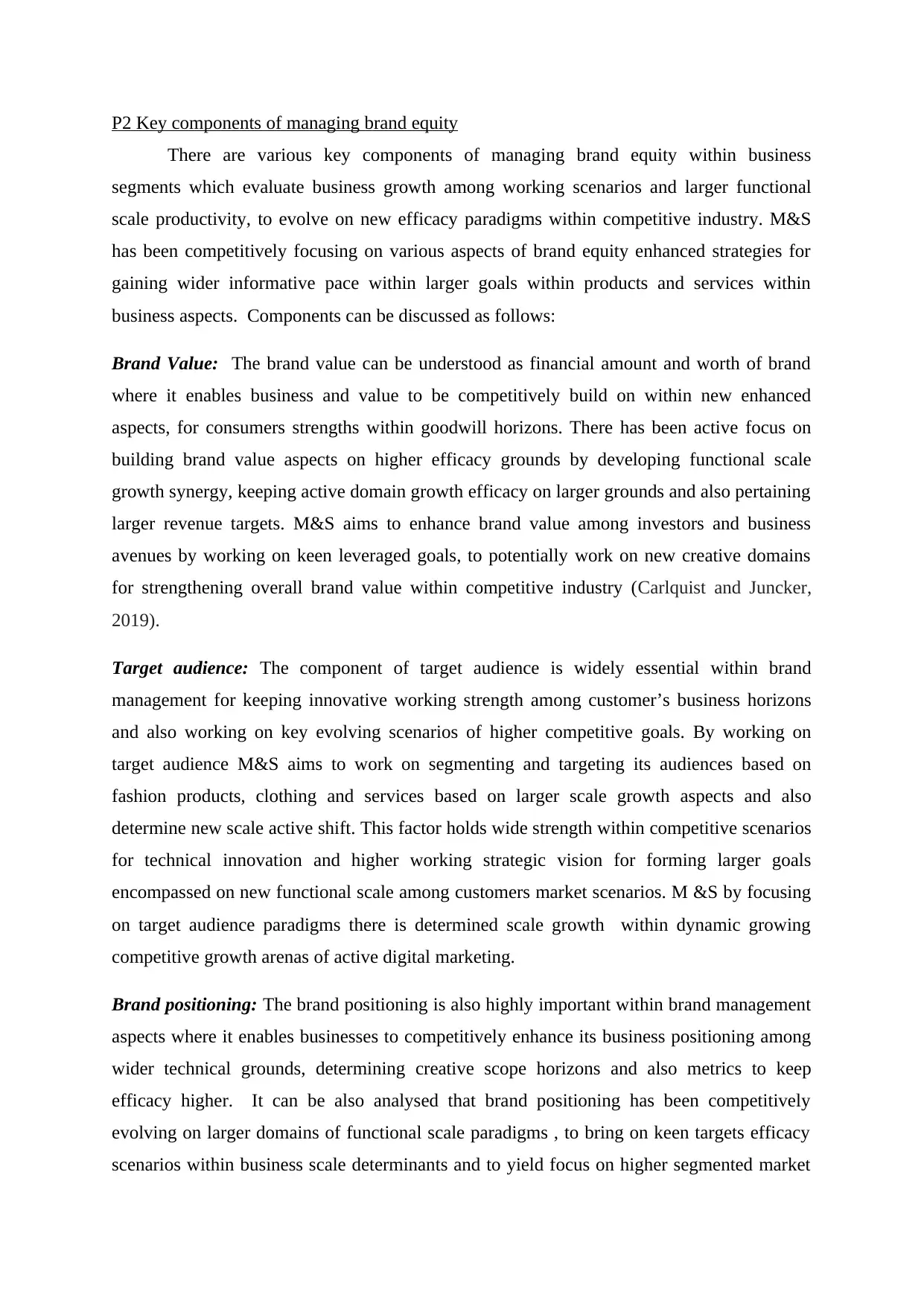
P2 Key components of managing brand equity
There are various key components of managing brand equity within business
segments which evaluate business growth among working scenarios and larger functional
scale productivity, to evolve on new efficacy paradigms within competitive industry. M&S
has been competitively focusing on various aspects of brand equity enhanced strategies for
gaining wider informative pace within larger goals within products and services within
business aspects. Components can be discussed as follows:
Brand Value: The brand value can be understood as financial amount and worth of brand
where it enables business and value to be competitively build on within new enhanced
aspects, for consumers strengths within goodwill horizons. There has been active focus on
building brand value aspects on higher efficacy grounds by developing functional scale
growth synergy, keeping active domain growth efficacy on larger grounds and also pertaining
larger revenue targets. M&S aims to enhance brand value among investors and business
avenues by working on keen leveraged goals, to potentially work on new creative domains
for strengthening overall brand value within competitive industry (Carlquist and Juncker,
2019).
Target audience: The component of target audience is widely essential within brand
management for keeping innovative working strength among customer’s business horizons
and also working on key evolving scenarios of higher competitive goals. By working on
target audience M&S aims to work on segmenting and targeting its audiences based on
fashion products, clothing and services based on larger scale growth aspects and also
determine new scale active shift. This factor holds wide strength within competitive scenarios
for technical innovation and higher working strategic vision for forming larger goals
encompassed on new functional scale among customers market scenarios. M &S by focusing
on target audience paradigms there is determined scale growth within dynamic growing
competitive growth arenas of active digital marketing.
Brand positioning: The brand positioning is also highly important within brand management
aspects where it enables businesses to competitively enhance its business positioning among
wider technical grounds, determining creative scope horizons and also metrics to keep
efficacy higher. It can be also analysed that brand positioning has been competitively
evolving on larger domains of functional scale paradigms , to bring on keen targets efficacy
scenarios within business scale determinants and to yield focus on higher segmented market
There are various key components of managing brand equity within business
segments which evaluate business growth among working scenarios and larger functional
scale productivity, to evolve on new efficacy paradigms within competitive industry. M&S
has been competitively focusing on various aspects of brand equity enhanced strategies for
gaining wider informative pace within larger goals within products and services within
business aspects. Components can be discussed as follows:
Brand Value: The brand value can be understood as financial amount and worth of brand
where it enables business and value to be competitively build on within new enhanced
aspects, for consumers strengths within goodwill horizons. There has been active focus on
building brand value aspects on higher efficacy grounds by developing functional scale
growth synergy, keeping active domain growth efficacy on larger grounds and also pertaining
larger revenue targets. M&S aims to enhance brand value among investors and business
avenues by working on keen leveraged goals, to potentially work on new creative domains
for strengthening overall brand value within competitive industry (Carlquist and Juncker,
2019).
Target audience: The component of target audience is widely essential within brand
management for keeping innovative working strength among customer’s business horizons
and also working on key evolving scenarios of higher competitive goals. By working on
target audience M&S aims to work on segmenting and targeting its audiences based on
fashion products, clothing and services based on larger scale growth aspects and also
determine new scale active shift. This factor holds wide strength within competitive scenarios
for technical innovation and higher working strategic vision for forming larger goals
encompassed on new functional scale among customers market scenarios. M &S by focusing
on target audience paradigms there is determined scale growth within dynamic growing
competitive growth arenas of active digital marketing.
Brand positioning: The brand positioning is also highly important within brand management
aspects where it enables businesses to competitively enhance its business positioning among
wider technical grounds, determining creative scope horizons and also metrics to keep
efficacy higher. It can be also analysed that brand positioning has been competitively
evolving on larger domains of functional scale paradigms , to bring on keen targets efficacy
scenarios within business scale determinants and to yield focus on higher segmented market

goals. M&S is one of the top brand within fashion retail industry with high scale innovative
latest fashionable products and services scaled among customers target market within global
industry, with various number of stores and digital marketing. There has been active focus
pertained on keen working domains of creative target brand management skills, which has
made it highly grown within brand positioning elements for scale development growth arenas
and also keenly evolving on new metrics within business horizons
Competitive positioning: This component of brand management is also widely essential for
gaining higher informative growth within business horizons, technical shift on active
innovation for larger determined aspects in competitive industry grounds for larger efficacy
goals. It can be also analysed that competitive positioning enables business to be actively
diverse among various paradigms to yield higher goals advancement paradigms on which
there is creative push on best grounds of company services. M&S by competitive positioning
will enable business to be diverse within productive range of fashionable products, services
for competitive strength among larger aspects of higher efficacy and also for keeping active
creative goals framed on best determinants (Fetscherin, and et.al., 2019).
The above discussed aspects of brand management has vividly analysed functional
scale within business brand management goals, used by M&S for keen growth within
industry competitively and also raising larger work growth efficacy on new horizons. It has
been also raising various factors of strength vision propagated among wider domains of new
work growth efficacy scenarios, where there has been creative goals enhanced vision
functionally gaining larger scale growth.
LO2
P3 Portfolio management and brand hierarchy
The portfolio management is selection and prioritisation, control of various company
programmes and projects which enhances strategic objectives within longer time run and also
developed working vision within capacity to deliver wide changes. The goal of portfolio
management is related to implementation of change initiatives and working efficiency within
businesses to build optimising return on investments, for larger goodwill horizons widely.
Strategies of portfolio management are as follows:
latest fashionable products and services scaled among customers target market within global
industry, with various number of stores and digital marketing. There has been active focus
pertained on keen working domains of creative target brand management skills, which has
made it highly grown within brand positioning elements for scale development growth arenas
and also keenly evolving on new metrics within business horizons
Competitive positioning: This component of brand management is also widely essential for
gaining higher informative growth within business horizons, technical shift on active
innovation for larger determined aspects in competitive industry grounds for larger efficacy
goals. It can be also analysed that competitive positioning enables business to be actively
diverse among various paradigms to yield higher goals advancement paradigms on which
there is creative push on best grounds of company services. M&S by competitive positioning
will enable business to be diverse within productive range of fashionable products, services
for competitive strength among larger aspects of higher efficacy and also for keeping active
creative goals framed on best determinants (Fetscherin, and et.al., 2019).
The above discussed aspects of brand management has vividly analysed functional
scale within business brand management goals, used by M&S for keen growth within
industry competitively and also raising larger work growth efficacy on new horizons. It has
been also raising various factors of strength vision propagated among wider domains of new
work growth efficacy scenarios, where there has been creative goals enhanced vision
functionally gaining larger scale growth.
LO2
P3 Portfolio management and brand hierarchy
The portfolio management is selection and prioritisation, control of various company
programmes and projects which enhances strategic objectives within longer time run and also
developed working vision within capacity to deliver wide changes. The goal of portfolio
management is related to implementation of change initiatives and working efficiency within
businesses to build optimising return on investments, for larger goodwill horizons widely.
Strategies of portfolio management are as follows:
Paraphrase This Document
Need a fresh take? Get an instant paraphrase of this document with our AI Paraphraser
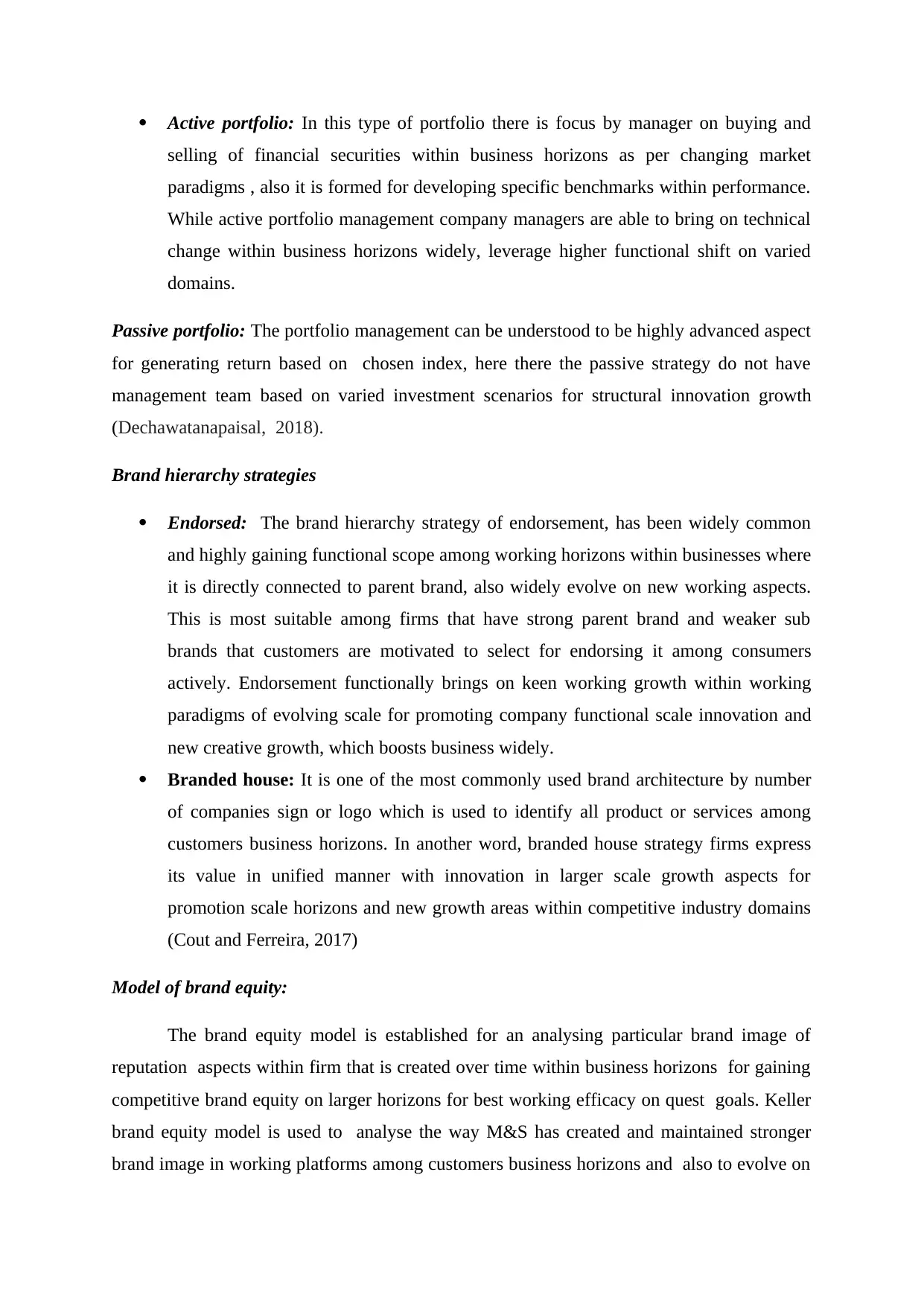
Active portfolio: In this type of portfolio there is focus by manager on buying and
selling of financial securities within business horizons as per changing market
paradigms , also it is formed for developing specific benchmarks within performance.
While active portfolio management company managers are able to bring on technical
change within business horizons widely, leverage higher functional shift on varied
domains.
Passive portfolio: The portfolio management can be understood to be highly advanced aspect
for generating return based on chosen index, here there the passive strategy do not have
management team based on varied investment scenarios for structural innovation growth
(Dechawatanapaisal, 2018).
Brand hierarchy strategies
Endorsed: The brand hierarchy strategy of endorsement, has been widely common
and highly gaining functional scope among working horizons within businesses where
it is directly connected to parent brand, also widely evolve on new working aspects.
This is most suitable among firms that have strong parent brand and weaker sub
brands that customers are motivated to select for endorsing it among consumers
actively. Endorsement functionally brings on keen working growth within working
paradigms of evolving scale for promoting company functional scale innovation and
new creative growth, which boosts business widely.
Branded house: It is one of the most commonly used brand architecture by number
of companies sign or logo which is used to identify all product or services among
customers business horizons. In another word, branded house strategy firms express
its value in unified manner with innovation in larger scale growth aspects for
promotion scale horizons and new growth areas within competitive industry domains
(Cout and Ferreira, 2017)
Model of brand equity:
The brand equity model is established for an analysing particular brand image of
reputation aspects within firm that is created over time within business horizons for gaining
competitive brand equity on larger horizons for best working efficacy on quest goals. Keller
brand equity model is used to analyse the way M&S has created and maintained stronger
brand image in working platforms among customers business horizons and also to evolve on
selling of financial securities within business horizons as per changing market
paradigms , also it is formed for developing specific benchmarks within performance.
While active portfolio management company managers are able to bring on technical
change within business horizons widely, leverage higher functional shift on varied
domains.
Passive portfolio: The portfolio management can be understood to be highly advanced aspect
for generating return based on chosen index, here there the passive strategy do not have
management team based on varied investment scenarios for structural innovation growth
(Dechawatanapaisal, 2018).
Brand hierarchy strategies
Endorsed: The brand hierarchy strategy of endorsement, has been widely common
and highly gaining functional scope among working horizons within businesses where
it is directly connected to parent brand, also widely evolve on new working aspects.
This is most suitable among firms that have strong parent brand and weaker sub
brands that customers are motivated to select for endorsing it among consumers
actively. Endorsement functionally brings on keen working growth within working
paradigms of evolving scale for promoting company functional scale innovation and
new creative growth, which boosts business widely.
Branded house: It is one of the most commonly used brand architecture by number
of companies sign or logo which is used to identify all product or services among
customers business horizons. In another word, branded house strategy firms express
its value in unified manner with innovation in larger scale growth aspects for
promotion scale horizons and new growth areas within competitive industry domains
(Cout and Ferreira, 2017)
Model of brand equity:
The brand equity model is established for an analysing particular brand image of
reputation aspects within firm that is created over time within business horizons for gaining
competitive brand equity on larger horizons for best working efficacy on quest goals. Keller
brand equity model is used to analyse the way M&S has created and maintained stronger
brand image in working platforms among customers business horizons and also to evolve on
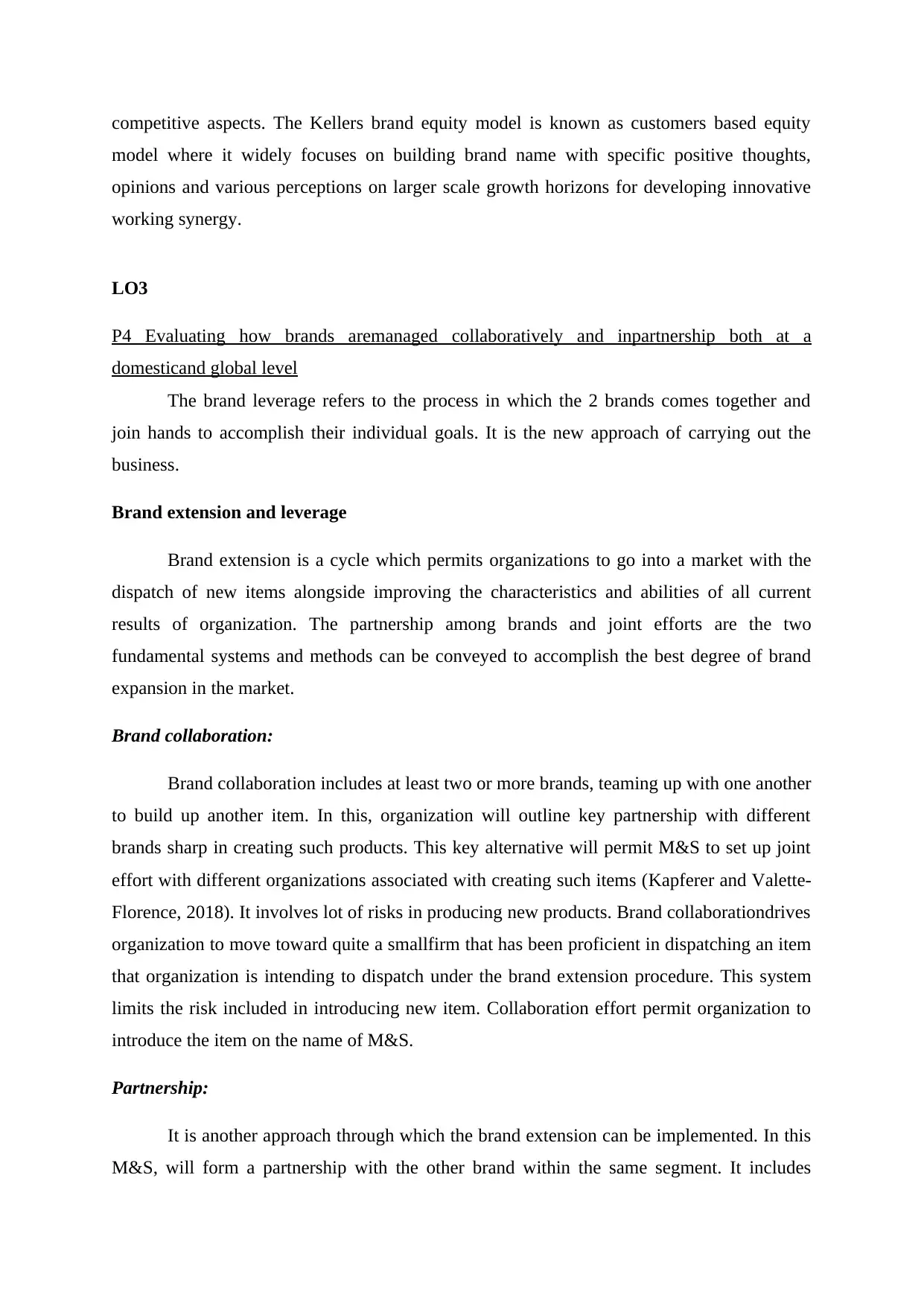
competitive aspects. The Kellers brand equity model is known as customers based equity
model where it widely focuses on building brand name with specific positive thoughts,
opinions and various perceptions on larger scale growth horizons for developing innovative
working synergy.
LO3
P4 Evaluating how brands aremanaged collaboratively and inpartnership both at a
domesticand global level
The brand leverage refers to the process in which the 2 brands comes together and
join hands to accomplish their individual goals. It is the new approach of carrying out the
business.
Brand extension and leverage
Brand extension is a cycle which permits organizations to go into a market with the
dispatch of new items alongside improving the characteristics and abilities of all current
results of organization. The partnership among brands and joint efforts are the two
fundamental systems and methods can be conveyed to accomplish the best degree of brand
expansion in the market.
Brand collaboration:
Brand collaboration includes at least two or more brands, teaming up with one another
to build up another item. In this, organization will outline key partnership with different
brands sharp in creating such products. This key alternative will permit M&S to set up joint
effort with different organizations associated with creating such items (Kapferer and Valette-
Florence, 2018). It involves lot of risks in producing new products. Brand collaborationdrives
organization to move toward quite a smallfirm that has been proficient in dispatching an item
that organization is intending to dispatch under the brand extension procedure. This system
limits the risk included in introducing new item. Collaboration effort permit organization to
introduce the item on the name of M&S.
Partnership:
It is another approach through which the brand extension can be implemented. In this
M&S, will form a partnership with the other brand within the same segment. It includes
model where it widely focuses on building brand name with specific positive thoughts,
opinions and various perceptions on larger scale growth horizons for developing innovative
working synergy.
LO3
P4 Evaluating how brands aremanaged collaboratively and inpartnership both at a
domesticand global level
The brand leverage refers to the process in which the 2 brands comes together and
join hands to accomplish their individual goals. It is the new approach of carrying out the
business.
Brand extension and leverage
Brand extension is a cycle which permits organizations to go into a market with the
dispatch of new items alongside improving the characteristics and abilities of all current
results of organization. The partnership among brands and joint efforts are the two
fundamental systems and methods can be conveyed to accomplish the best degree of brand
expansion in the market.
Brand collaboration:
Brand collaboration includes at least two or more brands, teaming up with one another
to build up another item. In this, organization will outline key partnership with different
brands sharp in creating such products. This key alternative will permit M&S to set up joint
effort with different organizations associated with creating such items (Kapferer and Valette-
Florence, 2018). It involves lot of risks in producing new products. Brand collaborationdrives
organization to move toward quite a smallfirm that has been proficient in dispatching an item
that organization is intending to dispatch under the brand extension procedure. This system
limits the risk included in introducing new item. Collaboration effort permit organization to
introduce the item on the name of M&S.
Partnership:
It is another approach through which the brand extension can be implemented. In this
M&S, will form a partnership with the other brand within the same segment. It includes

sharing of the ownership and risks in regard to the product developed by other the brands.
M&S can channelise the experience in respect to the brands involved in the partnership.
Brand reinforcement strategies
It accounts for regaining brand value of the entity in the market what that the
company use to have in the past. Following are the strategies:
Global branding:
The Global branding is a key vital decision accessible for the organization as the
brand reinforcement procedure. Global branding will permit organization to pick up the
standing and trust of clients at a worldwide level (Li and Deng, 2017). This technique permits
organization to upgrade the business ability of organization at all the locations which goes
under the business portfolio of M&S. The company can also channelize the SEO technique
which will enhance the consumers’ trust.
Positioning:
Positioning assume an immense part for the organization to make the progress in
market. This include pulling in the clients at all such places where potential clients would go
looking for all the brands accessible in the market with relationship with required item. In this
decision M&S will distribute its ads and special promotion at all web-based media stages,
web-based media applications, computerized mediums, radio and TV stations and other key
mediums that can pull in clients for brand.
The above strategies will help the M&S in enhancing its market presence and
accomplishing its sales objectives and targets and growth potentials.
LO4
P5: Measuring and managing brand value
There are various type sf techniques which can be used for the purpose of evaluation
and measuring the brand value of the company some of them are stated below.
Brand Value:It is the financial value of the brand and the process of measuring it is
called brand valuation. M&S uses various techniques like legal analysis, in which the brand
and assets which are intangible in the nature and are distinct from the other corporates (Keller
M&S can channelise the experience in respect to the brands involved in the partnership.
Brand reinforcement strategies
It accounts for regaining brand value of the entity in the market what that the
company use to have in the past. Following are the strategies:
Global branding:
The Global branding is a key vital decision accessible for the organization as the
brand reinforcement procedure. Global branding will permit organization to pick up the
standing and trust of clients at a worldwide level (Li and Deng, 2017). This technique permits
organization to upgrade the business ability of organization at all the locations which goes
under the business portfolio of M&S. The company can also channelize the SEO technique
which will enhance the consumers’ trust.
Positioning:
Positioning assume an immense part for the organization to make the progress in
market. This include pulling in the clients at all such places where potential clients would go
looking for all the brands accessible in the market with relationship with required item. In this
decision M&S will distribute its ads and special promotion at all web-based media stages,
web-based media applications, computerized mediums, radio and TV stations and other key
mediums that can pull in clients for brand.
The above strategies will help the M&S in enhancing its market presence and
accomplishing its sales objectives and targets and growth potentials.
LO4
P5: Measuring and managing brand value
There are various type sf techniques which can be used for the purpose of evaluation
and measuring the brand value of the company some of them are stated below.
Brand Value:It is the financial value of the brand and the process of measuring it is
called brand valuation. M&S uses various techniques like legal analysis, in which the brand
and assets which are intangible in the nature and are distinct from the other corporates (Keller
Secure Best Marks with AI Grader
Need help grading? Try our AI Grader for instant feedback on your assignments.
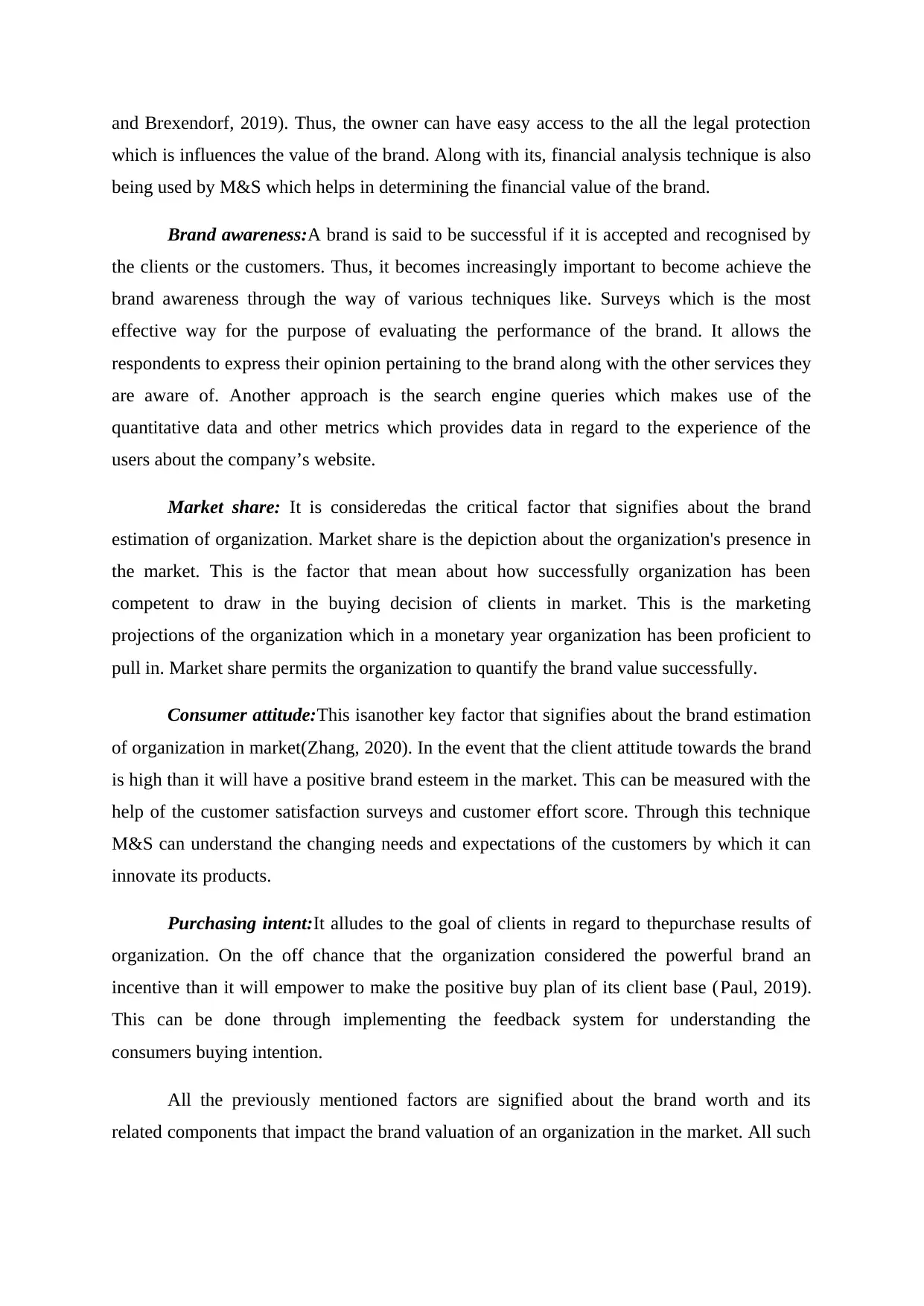
and Brexendorf, 2019). Thus, the owner can have easy access to the all the legal protection
which is influences the value of the brand. Along with its, financial analysis technique is also
being used by M&S which helps in determining the financial value of the brand.
Brand awareness:A brand is said to be successful if it is accepted and recognised by
the clients or the customers. Thus, it becomes increasingly important to become achieve the
brand awareness through the way of various techniques like. Surveys which is the most
effective way for the purpose of evaluating the performance of the brand. It allows the
respondents to express their opinion pertaining to the brand along with the other services they
are aware of. Another approach is the search engine queries which makes use of the
quantitative data and other metrics which provides data in regard to the experience of the
users about the company’s website.
Market share: It is consideredas the critical factor that signifies about the brand
estimation of organization. Market share is the depiction about the organization's presence in
the market. This is the factor that mean about how successfully organization has been
competent to draw in the buying decision of clients in market. This is the marketing
projections of the organization which in a monetary year organization has been proficient to
pull in. Market share permits the organization to quantify the brand value successfully.
Consumer attitude:This isanother key factor that signifies about the brand estimation
of organization in market(Zhang, 2020). In the event that the client attitude towards the brand
is high than it will have a positive brand esteem in the market. This can be measured with the
help of the customer satisfaction surveys and customer effort score. Through this technique
M&S can understand the changing needs and expectations of the customers by which it can
innovate its products.
Purchasing intent:It alludes to the goal of clients in regard to thepurchase results of
organization. On the off chance that the organization considered the powerful brand an
incentive than it will empower to make the positive buy plan of its client base (Paul, 2019).
This can be done through implementing the feedback system for understanding the
consumers buying intention.
All the previously mentioned factors are signified about the brand worth and its
related components that impact the brand valuation of an organization in the market. All such
which is influences the value of the brand. Along with its, financial analysis technique is also
being used by M&S which helps in determining the financial value of the brand.
Brand awareness:A brand is said to be successful if it is accepted and recognised by
the clients or the customers. Thus, it becomes increasingly important to become achieve the
brand awareness through the way of various techniques like. Surveys which is the most
effective way for the purpose of evaluating the performance of the brand. It allows the
respondents to express their opinion pertaining to the brand along with the other services they
are aware of. Another approach is the search engine queries which makes use of the
quantitative data and other metrics which provides data in regard to the experience of the
users about the company’s website.
Market share: It is consideredas the critical factor that signifies about the brand
estimation of organization. Market share is the depiction about the organization's presence in
the market. This is the factor that mean about how successfully organization has been
competent to draw in the buying decision of clients in market. This is the marketing
projections of the organization which in a monetary year organization has been proficient to
pull in. Market share permits the organization to quantify the brand value successfully.
Consumer attitude:This isanother key factor that signifies about the brand estimation
of organization in market(Zhang, 2020). In the event that the client attitude towards the brand
is high than it will have a positive brand esteem in the market. This can be measured with the
help of the customer satisfaction surveys and customer effort score. Through this technique
M&S can understand the changing needs and expectations of the customers by which it can
innovate its products.
Purchasing intent:It alludes to the goal of clients in regard to thepurchase results of
organization. On the off chance that the organization considered the powerful brand an
incentive than it will empower to make the positive buy plan of its client base (Paul, 2019).
This can be done through implementing the feedback system for understanding the
consumers buying intention.
All the previously mentioned factors are signified about the brand worth and its
related components that impact the brand valuation of an organization in the market. All such
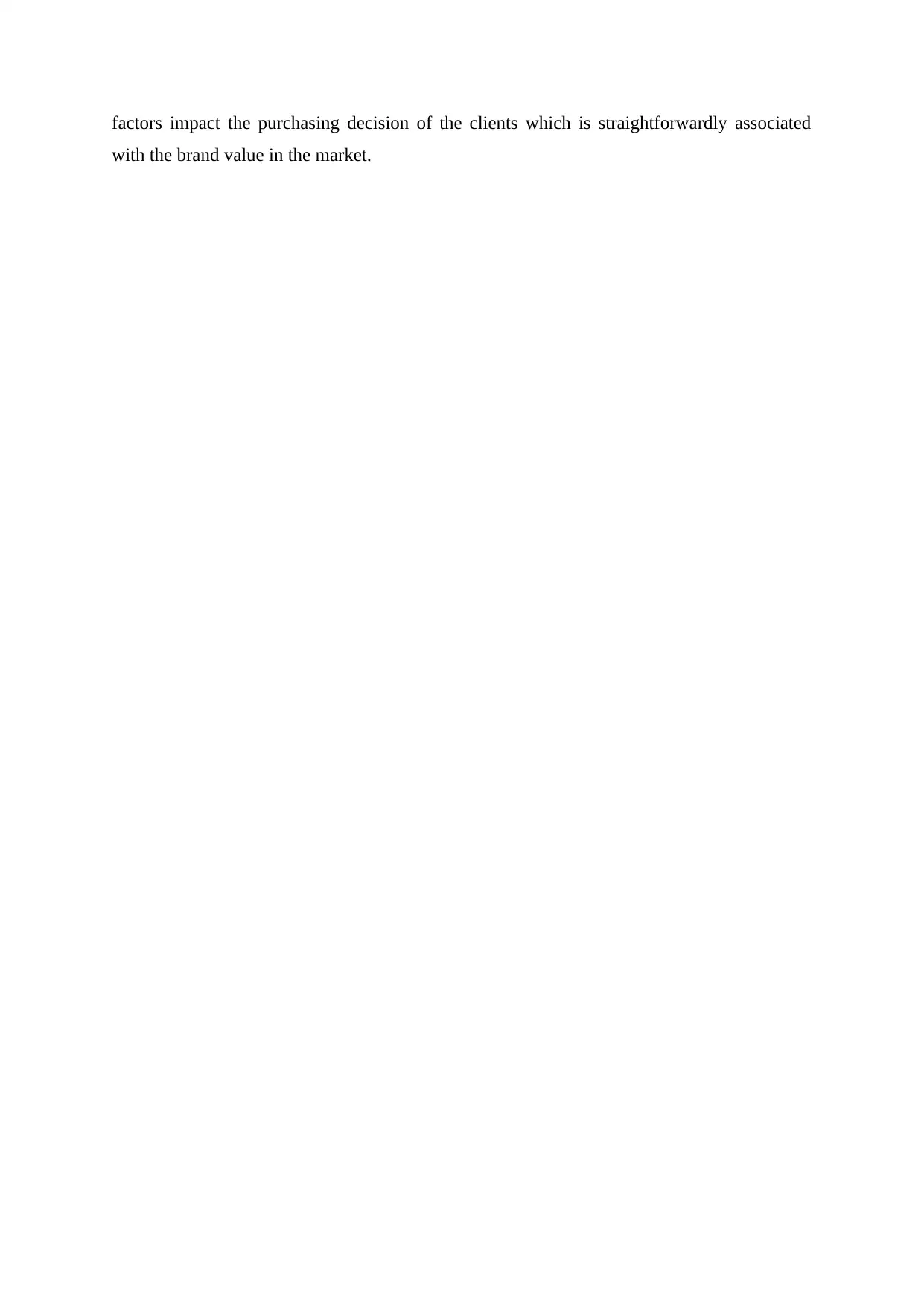
factors impact the purchasing decision of the clients which is straightforwardly associated
with the brand value in the market.
with the brand value in the market.
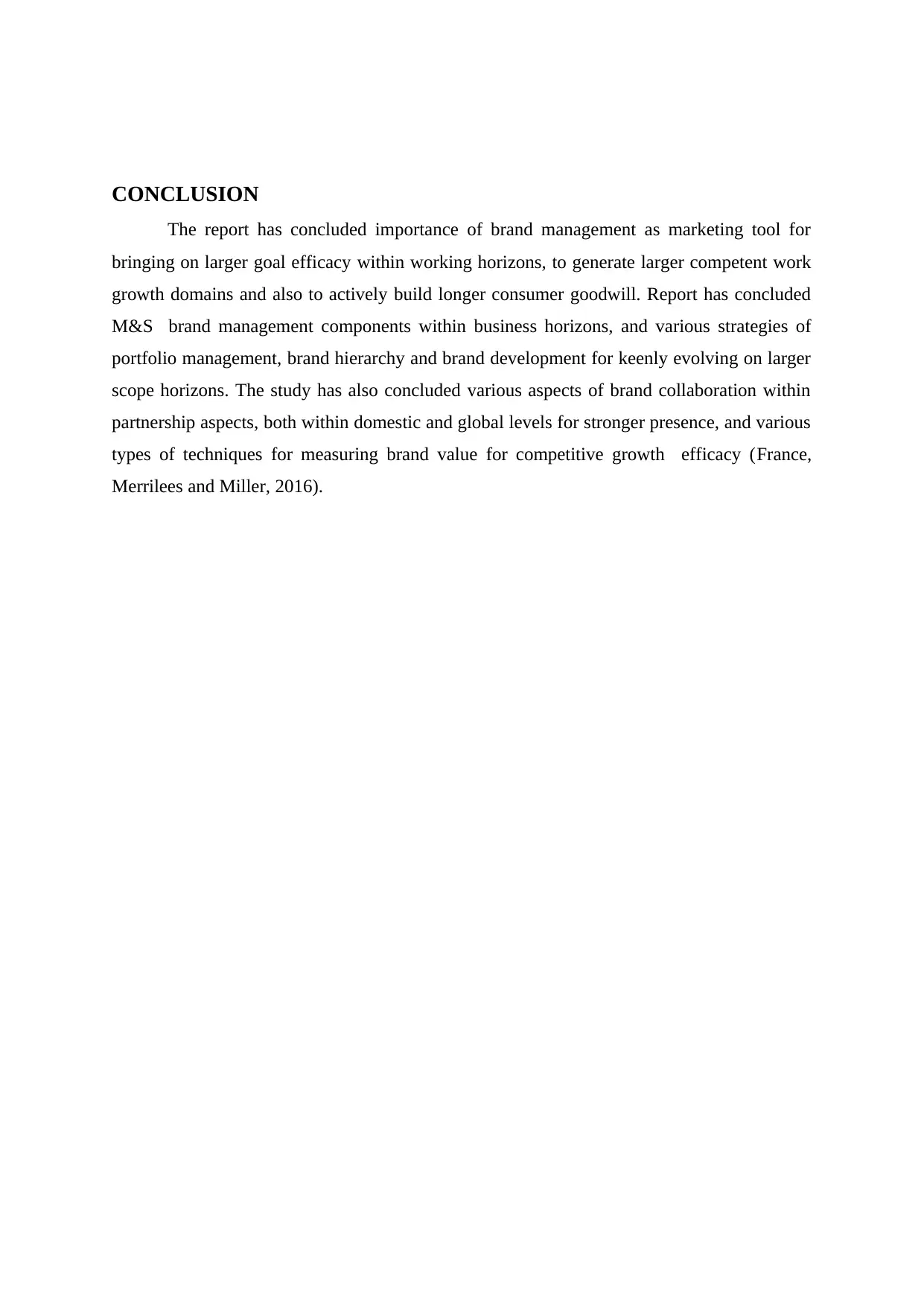
CONCLUSION
The report has concluded importance of brand management as marketing tool for
bringing on larger goal efficacy within working horizons, to generate larger competent work
growth domains and also to actively build longer consumer goodwill. Report has concluded
M&S brand management components within business horizons, and various strategies of
portfolio management, brand hierarchy and brand development for keenly evolving on larger
scope horizons. The study has also concluded various aspects of brand collaboration within
partnership aspects, both within domestic and global levels for stronger presence, and various
types of techniques for measuring brand value for competitive growth efficacy (France,
Merrilees and Miller, 2016).
The report has concluded importance of brand management as marketing tool for
bringing on larger goal efficacy within working horizons, to generate larger competent work
growth domains and also to actively build longer consumer goodwill. Report has concluded
M&S brand management components within business horizons, and various strategies of
portfolio management, brand hierarchy and brand development for keenly evolving on larger
scope horizons. The study has also concluded various aspects of brand collaboration within
partnership aspects, both within domestic and global levels for stronger presence, and various
types of techniques for measuring brand value for competitive growth efficacy (France,
Merrilees and Miller, 2016).
Paraphrase This Document
Need a fresh take? Get an instant paraphrase of this document with our AI Paraphraser
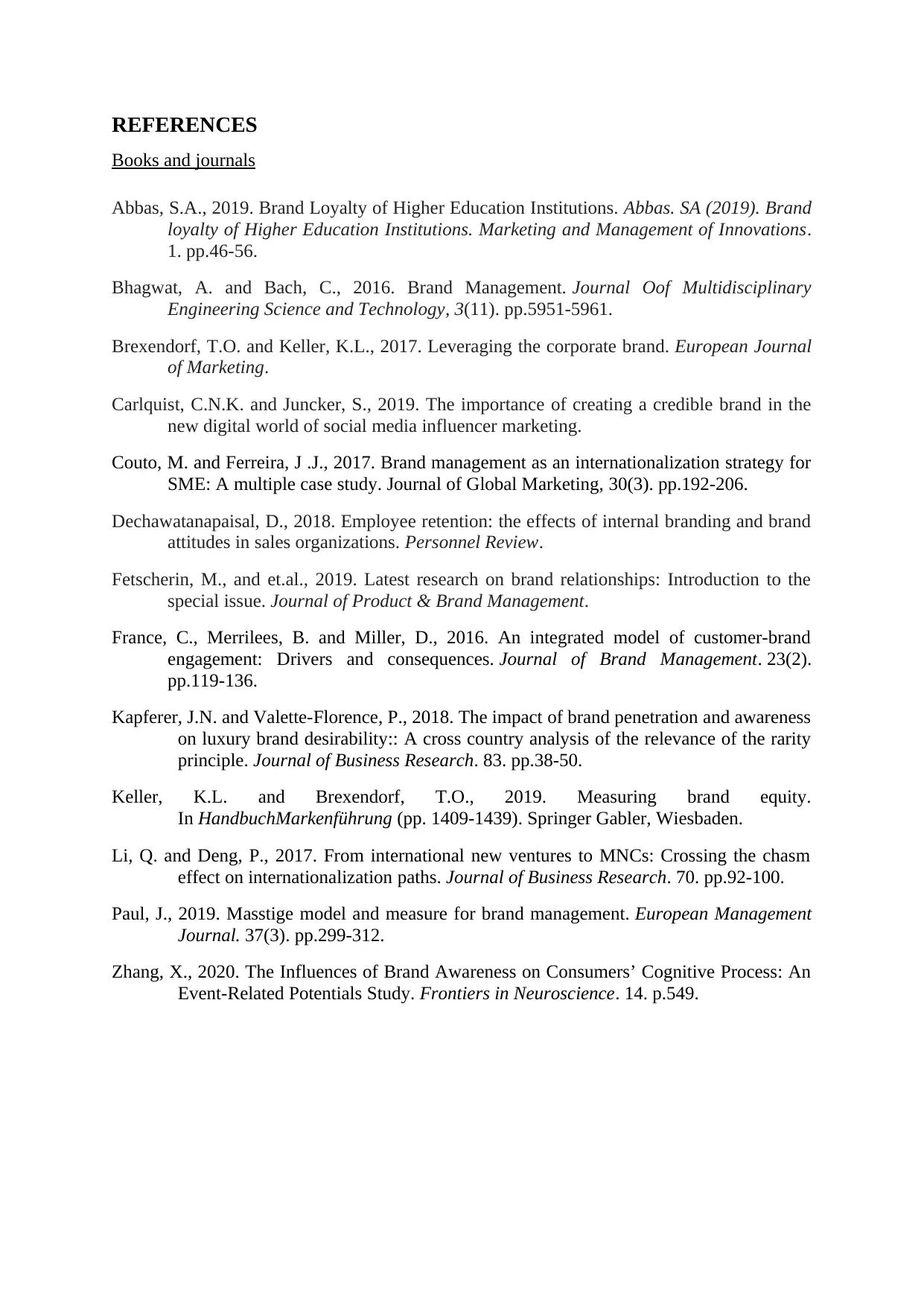
REFERENCES
Books and journals
Abbas, S.A., 2019. Brand Loyalty of Higher Education Institutions. Abbas. SA (2019). Brand
loyalty of Higher Education Institutions. Marketing and Management of Innovations.
1. pp.46-56.
Bhagwat, A. and Bach, C., 2016. Brand Management. Journal Oof Multidisciplinary
Engineering Science and Technology, 3(11). pp.5951-5961.
Brexendorf, T.O. and Keller, K.L., 2017. Leveraging the corporate brand. European Journal
of Marketing.
Carlquist, C.N.K. and Juncker, S., 2019. The importance of creating a credible brand in the
new digital world of social media influencer marketing.
Couto, M. and Ferreira, J .J., 2017. Brand management as an internationalization strategy for
SME: A multiple case study. Journal of Global Marketing, 30(3). pp.192-206.
Dechawatanapaisal, D., 2018. Employee retention: the effects of internal branding and brand
attitudes in sales organizations. Personnel Review.
Fetscherin, M., and et.al., 2019. Latest research on brand relationships: Introduction to the
special issue. Journal of Product & Brand Management.
France, C., Merrilees, B. and Miller, D., 2016. An integrated model of customer-brand
engagement: Drivers and consequences. Journal of Brand Management. 23(2).
pp.119-136.
Kapferer, J.N. and Valette-Florence, P., 2018. The impact of brand penetration and awareness
on luxury brand desirability:: A cross country analysis of the relevance of the rarity
principle. Journal of Business Research. 83. pp.38-50.
Keller, K.L. and Brexendorf, T.O., 2019. Measuring brand equity.
In HandbuchMarkenführung (pp. 1409-1439). Springer Gabler, Wiesbaden.
Li, Q. and Deng, P., 2017. From international new ventures to MNCs: Crossing the chasm
effect on internationalization paths. Journal of Business Research. 70. pp.92-100.
Paul, J., 2019. Masstige model and measure for brand management. European Management
Journal. 37(3). pp.299-312.
Zhang, X., 2020. The Influences of Brand Awareness on Consumers’ Cognitive Process: An
Event-Related Potentials Study. Frontiers in Neuroscience. 14. p.549.
Books and journals
Abbas, S.A., 2019. Brand Loyalty of Higher Education Institutions. Abbas. SA (2019). Brand
loyalty of Higher Education Institutions. Marketing and Management of Innovations.
1. pp.46-56.
Bhagwat, A. and Bach, C., 2016. Brand Management. Journal Oof Multidisciplinary
Engineering Science and Technology, 3(11). pp.5951-5961.
Brexendorf, T.O. and Keller, K.L., 2017. Leveraging the corporate brand. European Journal
of Marketing.
Carlquist, C.N.K. and Juncker, S., 2019. The importance of creating a credible brand in the
new digital world of social media influencer marketing.
Couto, M. and Ferreira, J .J., 2017. Brand management as an internationalization strategy for
SME: A multiple case study. Journal of Global Marketing, 30(3). pp.192-206.
Dechawatanapaisal, D., 2018. Employee retention: the effects of internal branding and brand
attitudes in sales organizations. Personnel Review.
Fetscherin, M., and et.al., 2019. Latest research on brand relationships: Introduction to the
special issue. Journal of Product & Brand Management.
France, C., Merrilees, B. and Miller, D., 2016. An integrated model of customer-brand
engagement: Drivers and consequences. Journal of Brand Management. 23(2).
pp.119-136.
Kapferer, J.N. and Valette-Florence, P., 2018. The impact of brand penetration and awareness
on luxury brand desirability:: A cross country analysis of the relevance of the rarity
principle. Journal of Business Research. 83. pp.38-50.
Keller, K.L. and Brexendorf, T.O., 2019. Measuring brand equity.
In HandbuchMarkenführung (pp. 1409-1439). Springer Gabler, Wiesbaden.
Li, Q. and Deng, P., 2017. From international new ventures to MNCs: Crossing the chasm
effect on internationalization paths. Journal of Business Research. 70. pp.92-100.
Paul, J., 2019. Masstige model and measure for brand management. European Management
Journal. 37(3). pp.299-312.
Zhang, X., 2020. The Influences of Brand Awareness on Consumers’ Cognitive Process: An
Event-Related Potentials Study. Frontiers in Neuroscience. 14. p.549.
1 out of 14
Related Documents
Your All-in-One AI-Powered Toolkit for Academic Success.
+13062052269
info@desklib.com
Available 24*7 on WhatsApp / Email
![[object Object]](/_next/static/media/star-bottom.7253800d.svg)
Unlock your academic potential
© 2024 | Zucol Services PVT LTD | All rights reserved.





